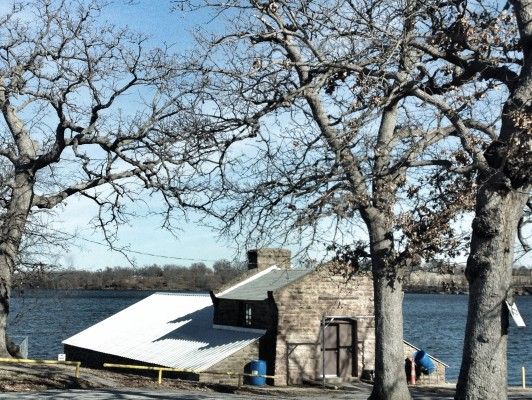Telling the history of Claremore one story at a time
BOATHOUSE JAIL
Claremore Daily Progress August 3, 2011 Larry Larkin Progress Correspondent
It seemed to be a simple request and an interesting one to boot. Family friend Bob Clements approached me after Sunday church services a few weeks back and we were visiting in the parking lot. As we started to depart he causally said I should write an article about the jail cell at Claremore Lake.
Whoa, wait a minute. There is no jail cell that I know about and my parents have lived on that lake going on now almost a half century. Oh yes there is. It is in the old rock boathouse and it has an interesting history, he corrected me with a wide smile across his face. There would be no reason for this wise gentleman to make up such a tale. He didn’t have all the details and I am positive he was never incarcerated in the cell. Still what he told me was enough to start a fact-finding journey to learn more. Bob said to watch out for the water moccasins. That was an attention-getter also.
First step was to see the structure for myself. I had to know a little more detail before seeking additional information. The lake attendants on duty when I arrived said yes, the boathouse certainly did have a cell; no, they didn’t know why or when it was used; and yes, I could see it.
The jail cell is directly under the former lake office. The solid steel door had been removed and now is leaning up against the wall nearest the boat ramps. The only window was about 12 inches square. Encased in concrete were one-inch rebar pipes, crisscrossing the opening. This allowed the only light into the cell. The 40-watt light bulbs over the docks didn’t produce much light to start out.
The floor was concrete and covered with lake water. This has been the case since the level of the lake was raised back in the 1970s. About two feet of pitch black water was in the cell that day. The rangers said they had removed the snakes, but I noticed one of them still carried a long pole in case it was needed. I stayed behind him during my visit, only peeking around him to take a few pictures. Telephone calls and personal visits followed. Surely someone would know the building’s history.
A Stagecoach Stop? One local historian said an old stagecoach line ran across that area before the lake was built. It was used to store food and weapons. Another said the jail was used by Judge Isaac Parker’s deputies back before statehood. It was a resting point as they returned prisoners to Ft. Smith for trial. Both were great stories, but they were not true. The lake wasn’t formed until 1930-31 for the purpose of supplying drinking water to the city of Claremore. The building housing the boat dock and jail wasn’t constructed until 1938.
This key information was furnished by current Claremore Police Officer Jamie Starling. She is currently gathering records and other facts concerning past and present officers who have served the city as law enforcement officers. Her research revealed Claremore’s first jail was built between 1901 and ‘03 near Cherokee and Fifth Streets. When the first city hall building went up on the corner of Muskogee and Main, it contained a six cell jail beneath the southwest corner. In later years the police department had a holding cell, but most lawbreakers were taken to the Rogers County jail at the court house.
What about the cell at the lake? Continuing her search, Starling found papers showing it was used by city officers as a jail. This confirmed what Clements had told me earlier. This came from information used in 1985 in an apparent unsuccessful bid to get the boat house on the National Register of Historic Places. The building was described as a two-story structure constructed of cut native stone. Entry into the building is actually the second floor that has one small room with a chimney. Stairs off to the side lead to the lower level that contains a pair of boat ramps and “…a small room that Claremore policemen once used as a jail.”
The 1938 builder and architect are apparently unknown today. We do know the construction was a Works Progress Administration project. It enabled the WPA to infuse wages of some 16,200 man-hours of labor into the local economy. It was one of the few WPA-built boathouses in Oklahoma. It may be the only one still standing.
Two questions remain about the cell: Why was it part of the boat house? Was it really used to house prisoners? The reason of it being included in the boat house remains a mystery.
Both John Dudley and Chester “Hoopie” Baldwin, retired local policemen, said they knew the cell was at the lake. They agreed it was never used during their careers, or had they heard of it used by officers before them. Claremore Mayor Mickey Perry, former police chief, said the same thing. According to stories from long-time residents, Clements was told the policemen would use it only for “troublesome” prisoners. If a person was causing serious problems while being arrested or jailed, he was simply transported to the lake for an overnight stay. It’s said that one dark night visiting the catfish and water moccasins was all it took for a remarkable improvement of attitude.



